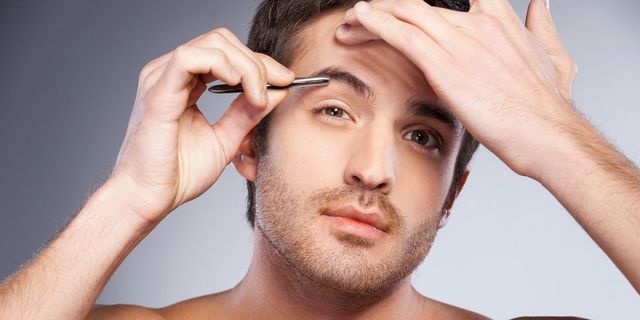The official term for that white, flaky stuff on your eyebrows is seborrheic dermatitis, which is basically dandruff. The hallmark features of it are yellowish, greasy scales or patches on top of red, irritated skin.
Usually, the condition will show up around or after puberty in areas of your skin where there are lots of oil glands—that’s why many men get dandruff on their scalps.
Other common locations include your eyebrows, the skin between your eyebrows, your eyelashes, around your nose, inside and around your ears, and the area around your moustache or beard.
Related: 12 Common Skin Problems—and How You Can Fix Them
It can also occur below the neck, on places like the center of your upper chest, under your arms, in your bellow button, or around your groin.
Doctors aren’t quite sure what’s behind the condition, but it seems like a specific type of fungus from the Malassezia family is involved.
When this oil-loving fungus feeds off the products of our oil glands, it can cause irritation or allergic reactions in some people. This leads to inflammation, which results in the flaking and the red, itchy skin seen with dandruff.
As a dermatologist, I treat this dandruff by working to decrease the amount of this fungus and minimizing the inflammation.
Related: How to Treat Toenail Fungus
An anti-dandruff shampoo that contains ketoconazole, selenium sulfide, zinc pyrithione, sodium sulfacetamide, salicylic acid or coal tar is one of the easiest and simplest treatments for clearing up the condition on your scalp.
And you can use the same shampoo to fight the condition on your eyebrows or elsewhere on your face, too.
Simply use the shampoo as a face wash: Work it into a later, and then massage into the affected areas on your face. Let it soak in for 3 to 5 minutes before washing off, so it can effectively reach the fungus and decrease the inflammation.
Try your best not to get it into your eyes—many of these shampoos can cause irritation. If you do, simply rinse well with clean water.
Related: The Best Shampoo For Your Hair Type
If the scaly skin on your face is very thick, you can massage oil on it—I like coconut oil best—to soften and remove the scale before treating it with the shampoo.
You can also apply a hydrocortisone 1 percent cream after washing to help with the redness and the inflammation, especially if there is itching.
Related: How to Stop Bug Bites From Itching
If you want to take the natural route, rubbing tea tree oil into the affected area can be effective, too. You just need to be careful about using undiluted tea tree essential oil directly on your skin, since it can cause allergic or irritant reactions.
So stick to concentrations between 5 and 20 percent. Most products don’t list a percentage, so you can make your own to be sure you’re not using too harsh a concentration.
Make a 5 percent solution by diluting straight tea tree oil: Just add 15 drops of the tea tree oil to a tablespoon of coconut oil, aloe gel, warm water or any cream of cleanser you like.
In fact, mixing it with aloe is my favorite home remedy because aloe is both soothing and can help minimize the inflammation.
Initially, you should treat this daily until your skin starts to calm down and you begin seeing an improvement—then you can back off to treating once every other day, and slowly decrease it until you’re treating once or twice a week.
Related: The Fastest Ways to Get Rid Of Zits, Ingrown Hairs, and 5 Other Annoying Skin Problems
Seborrheic dermatitis is a chronic condition, so it tends to require long-term maintenance. So the options above will treat it and control it, but they won’t actually cure it.
That’s because the condition will flare up at times, especially during periods of stress or during the cold winter months.
If you have tried these options and haven’t seen an improvement in your flakes, check in with your dermatologist.
Related: 6 Surprising Reasons to See a Dermatologist
He or she may recommend more aggressive treatment options like prescription-strength creams or oral medications for very severe cases.
Apple A. Bodemer, M.D., is an integrative dermatologist at UW Health and an assistant professor of dermatology at the University of Wisconsin School of Medicine and Public Health.














